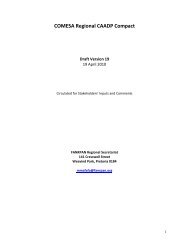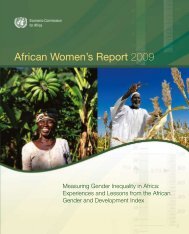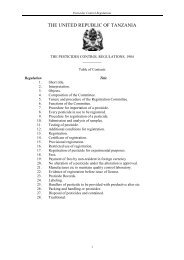Community-driven development decision tools for rural - IFAD
Community-driven development decision tools for rural - IFAD
Community-driven development decision tools for rural - IFAD
- No tags were found...
You also want an ePaper? Increase the reach of your titles
YUMPU automatically turns print PDFs into web optimized ePapers that Google loves.
IICDD and local governanceDefinition of governanceCDD is closely related to the issue of governance at the community level. The definitions ofgovernance are provided in Box 9.A study sponsored by the World Bank 9 mentions these six dimensions of governance:• voice and accountability (e.g. political, civil, and human rights);• political stability and absence of violence;• government effectiveness (i.e. competence of the bureaucracy);• regulatory quality (i.e. existence of market-friendly policies);• rule of law (i.e. the quality of the police and the judiciary);• control of corruption (i.e. the abuse of public power <strong>for</strong> private gain).The quality of governanceEquitable and participatory <strong>rural</strong> <strong>development</strong> and <strong>rural</strong> poverty alleviation cannot besuccessfully promoted in a poor governance environment. There is broad consensus today thatimproving local governance is a major <strong>development</strong> task and a condition to making targetedinitiatives effective and sustainable.Governance can be assessed on the basis of its quality and on the extent to which governanceobjectives are actually achieved. “Good governance” is a value-laden concept used in this paperto indicate improvements in the quality of governance (e.g. more responsiveness, moretransparency, more accountability) and progress in achieving its key objectives (e.g. stability,growth, equity, sustainability and efficient use of resources).Box 11 indicates that one feature of the quality of governance is the accountability of agoverning body to those who are governed. But what does this mean? Two aspects are important:answerability (i.e. accountable actors must explain and publicly justify their <strong>decision</strong>s) anden<strong>for</strong>ceability (i.e. accountable persons must bear the consequences of their <strong>decision</strong>s, includingthe possibility of incurring negative sanctions). 10A pluralist governance system envisages the <strong>development</strong> of strong CSOs and private enterprisesand the creation of competitive markets <strong>for</strong> goods and services. This establishes multiple centreswith the power to make and implement <strong>decision</strong>s in the political, social and economic fields.Box 9What is “governance”?Governance is the system of values, policiesand institutions by which a society manages itseconomic, political and social affairs throughinteractions within and among the state, civilsociety and private sector (UNDP, HumanDevelopment Report, 2004).Collective governance implies havingaccepted endogenous rules, and communityand organizational institutions responsible <strong>for</strong>applying those rules and collective actions ofinterest to the members of the community.Good governance is a system of collectivegovernance that• operates in a transparent manner;• is responsive and accountable tothe members of the community;• manages collective affairs in sucha way as to enhance <strong>development</strong>opportunities <strong>for</strong> all, improveefficiency and equity in using commonresources, and resolve potentialconflicts among communitymembers peacefully.9 Kaufmann et al., 2005, quoted in “Access to Governance and Policy Processes”, cit.10 Schedler A. (1999). “Conceptualizing accountability”, in The self-restraining state: power and accountability in new democraciesquoted in Access to governance and policy processes, <strong>IFAD</strong> 2008, op. cit. page 8.20
















